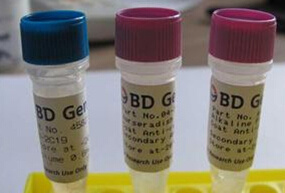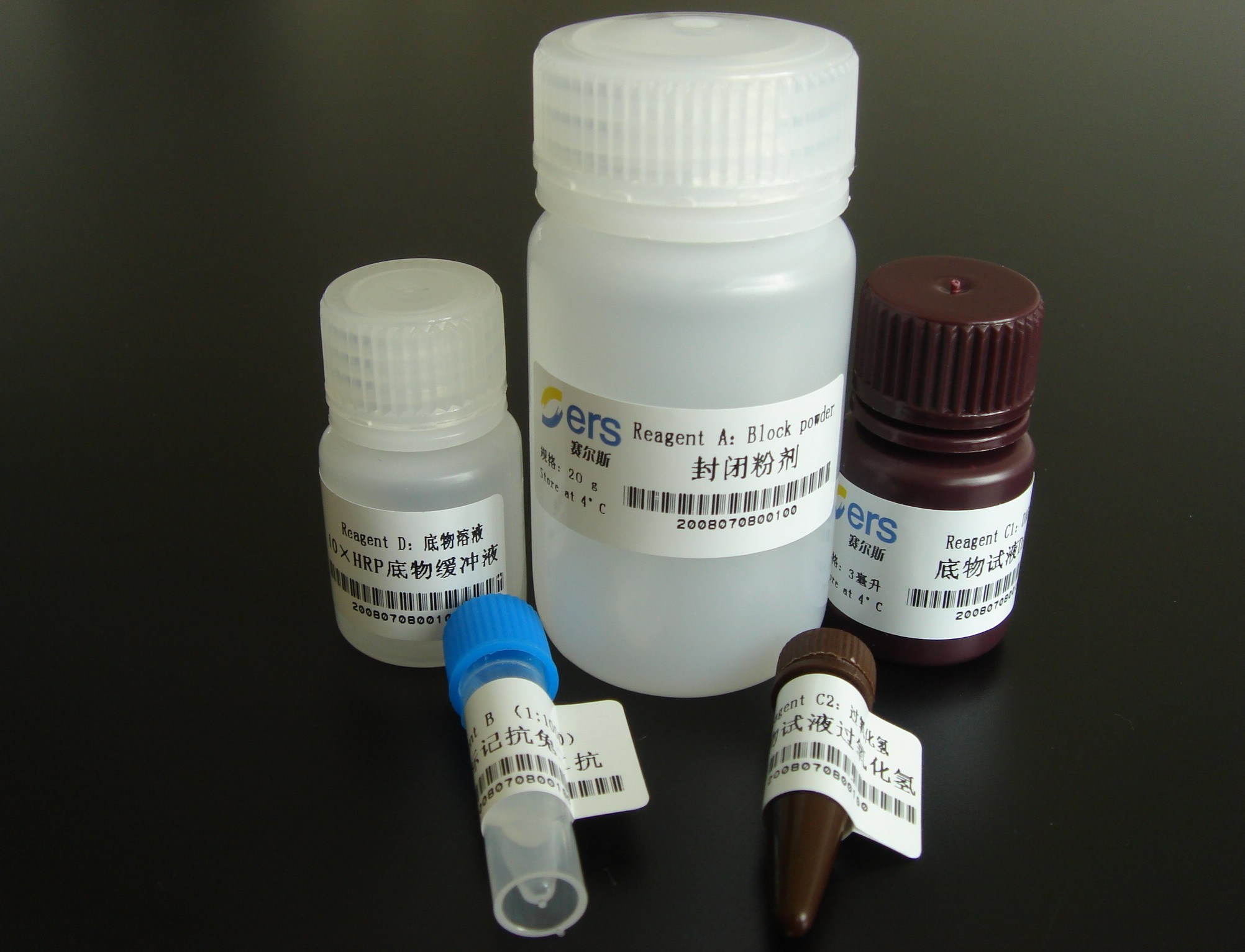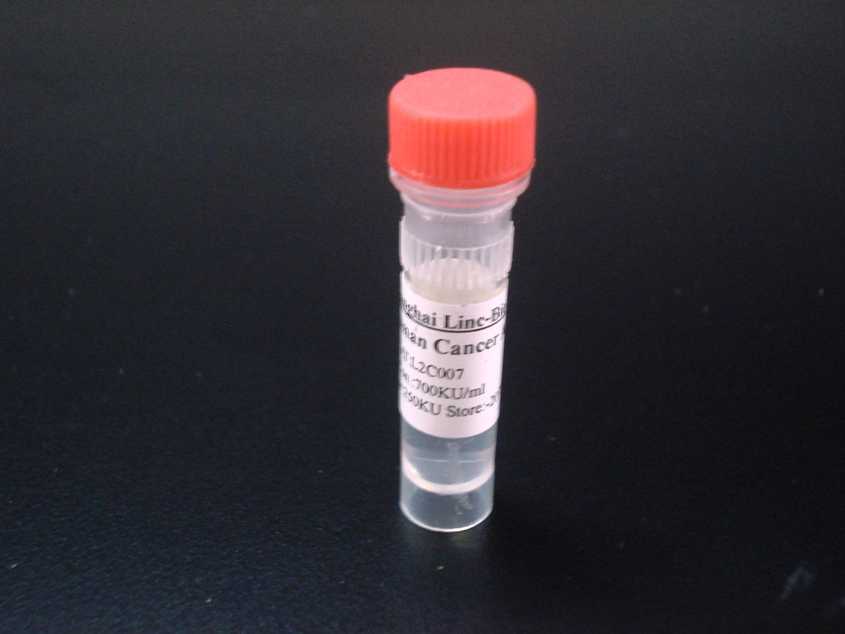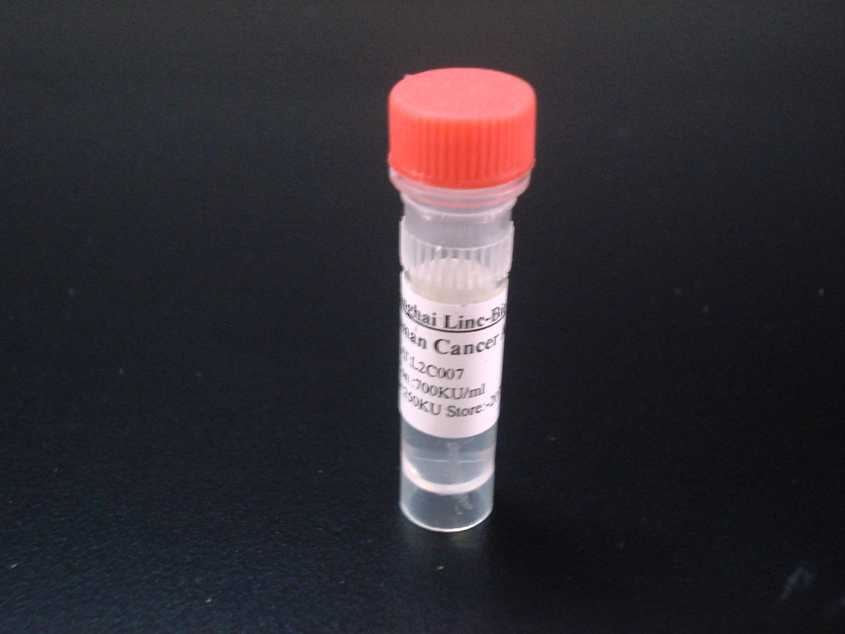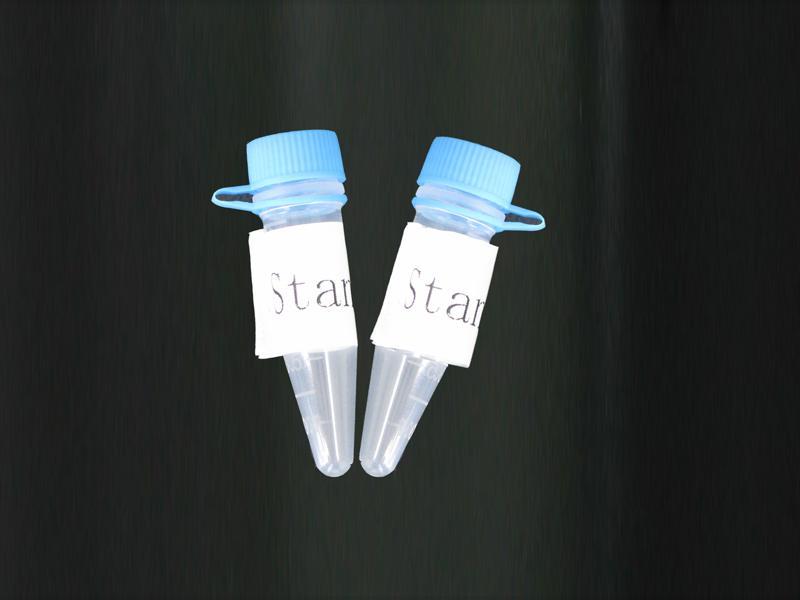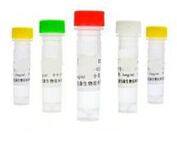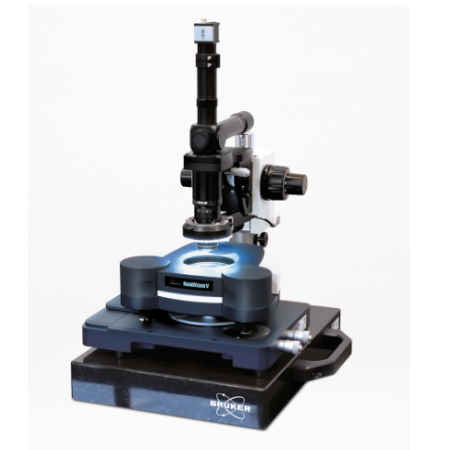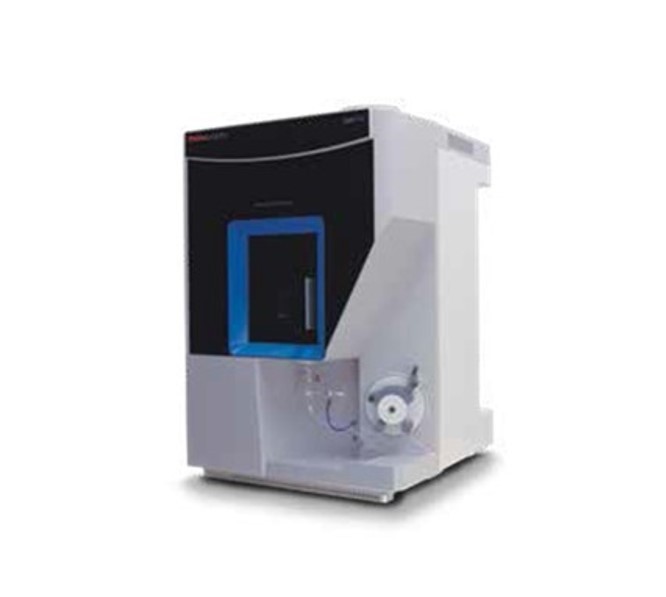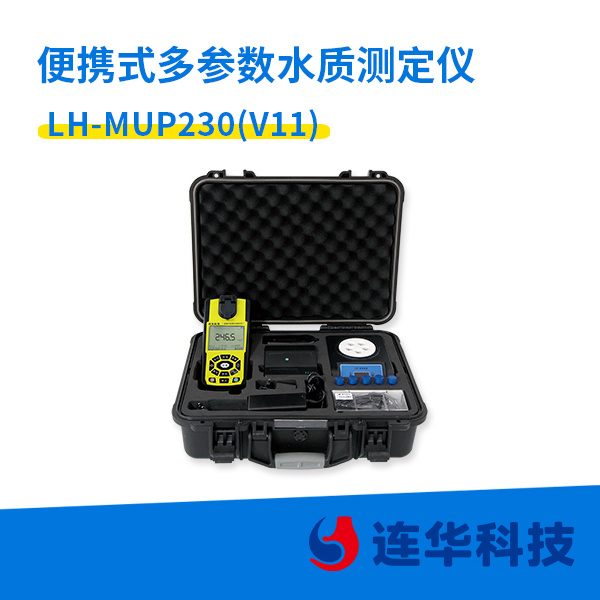英文名称 TGF beta Receptor II
中文名称 转移生长因子β受体2抗体
别 名 TGF beta R2; TGFBR2; TGF beta Receptor II; AAT 3; AAT3; FAA 3; FAA3; HNPCC6; MFS 2; MFS2; RIIC; TAAD 2; TAAD2; TbetaR II; TGF beta receptor type 2; TGF beta receptor type II; TGF beta type II receptor; TGFB R2; TGFbeta RII; TGFBR 2; TGFBR2; TGFR 2; TGFR2; Transforming growth factor beta receptor II; Transforming growth factor beta receptor type II;
转移生长因子β受体2抗体
说 明 书 0.1ml 0.2ml 1ml
研究领域 肿瘤 细胞生物 神经生物学 信号转导 生长因子和激素 激酶和磷酸酶 细胞膜受体 细胞分化
抗体来源 Rabbit
克隆类型 Polyclonal
交叉反应 Human, Mouse, Rat, Chicken, Pig, Cow, Horse, Rabbit, Sheep,
产品应用 WB=1:100-500 ELISA=1:500-1000 IP=1:20-100 IHC-P=1:100-500 IHC-F=1:100-500 IF=1:100-500 (石蜡切片需做抗原修复)
not yet tested in other applications.
optimal dilutions/concentrations should be determined by the end user.
分 子 量 62kDa
细胞定位 细胞膜
性 状 Lyophilized or Liquid
浓 度 1mg/1ml
免 疫 原 KLH conjugated synthetic peptide derived from human TGF beta R2
亚 型 IgG
纯化方法 affinity purified by Protein A
储 存 液 0.01M PBS, pH 7.4 with 10 mg/ml BSA and 0.1% Sodium azide
保存条件 Store at -20 °C for one year. Avoid repeated freeze/thaw cycles. The lyophilized antibody is stable at room temperature for at least one month and for greater than a year when kept at -20°C. When reconstituted in sterile pH 7.4 0.01M PBS or diluent of antibody the antibody is stable for at least two weeks at 2-4 °C.
转移生长因子β受体2抗体 产品介绍 background:
This gene encodes a member of the Ser/Thr protein kinase family and the TGFB receptor subfamily. The encoded protein is a transmembrane protein that has a protein kinase domain, forms a heterodimeric complex with another receptor protein, and binds TGF-beta. This receptor/ligand complex phosphorylates proteins, which then enter the nucleus and regulate the transcription of a subset of genes related to cell proliferation. Mutations in this gene have been associated with Marfan Syndrome, Loeys-Deitz Aortic Aneurysm Syndrome, and the development of various types of tumors. Alternatively spliced transcript variants encoding different isoforms have been characterized.
Function:
Transmembrane serine/threonine kinase forming with the TGF-beta type I serine/threonine kinase receptor, TGFBR1, the non-promiscuous receptor for the TGF-beta cytokines TGFB1, TGFB2 and TGFB3. Transduces the TGFB1, TGFB2 and TGFB3 signal from the cell surface to the cytoplasm and is thus regulating a plethora of physiological and pathological processes including cell cycle arrest in epithelial and hematopoietic cells, control of mesenchymal cell proliferation and differentiation, wound healing, extracellular matrix production, immunosuppression and carcinogenesis. The formation of the receptor complex composed of 2 TGFBR1 and 2 TGFBR2 molecules symmetrically bound to the cytokine dimer results in the phosphorylation and the activation of TGFRB1 by the constitutively active TGFBR2. Activated TGFBR1 phosphorylates SMAD2 which dissociates from the receptor and interacts with SMAD4. The SMAD2-SMAD4 complex is subsequently translocated to the nucleus where it modulates the transcription of the TGF-beta-regulated genes. This constitutes the canonical SMAD-dependent TGF-beta signaling cascade. Also involved in non-canonical, SMAD-independent TGF-beta signaling pathways.
Subunit:
Homodimer. Heterohexamer; TGFB1, TGFB2 and TGFB3 homodimeric ligands assemble a functional receptor composed of two TGFBR1 and TGFBR2 heterodimers to form a ligand-receptor heterohexamer. The respective affinity of TGFRB1 and TGFRB2 for the ligands may modulate the kinetics of assembly of the receptor and may explain the different biological activities of TGFB1, TGFB2 and TGFB3. Interacts with DAXX. Interacts with TCTEX1D4. Interacts with ZFYVE9; ZFYVE9 recruits SMAD2 and SMAD3 to the TGF-beta receptor.
Subcellular Location:
Cell membrane; Single-pass type I membrane protein.
Post-translational modifications:
Phosphorylated on a Ser/Thr residue in the cytoplasmic domain.
DISEASE:
Defects in TGFBR2 are the cause of hereditary non-polyposis colorectal cancer type 6 (HNPCC6) [MIM:614331]. Mutations in more than one gene locus can be involved alone or in combination in the production of the HNPCC phenotype (also called Lynch syndrome). Most families with clinically recognized HNPCC have mutations in either MLH1 or MSH2 genes. HNPCC is an autosomal, dominantly inherited disease associated with marked increase in cancer susceptibility. It is characterized by a familial predisposition to early onset colorectal carcinoma (CRC) and extra-colonic cancers of the gastrointestinal, urological and female reproductive tracts. HNPCC is reported to be the most common form of inherited colorectal cancer in the Western world, and accounts for 15% of all colon cancers. Cancers in HNPCC originate within benign neoplastic polyps termed adenomas. Clinically, HNPCC is often divided into two subgroups. Type I: hereditary predisposition to colorectal cancer, a young age of onset, and carcinoma observed in the proximal colon. Type II: patients have an increased risk for cancers in certain tissues such as the uterus, ovary, breast, stomach, small intestine, skin, and larynx in addition to the colon. Diagnosis of classical HNPCC is based on the Amsterdam criteria: 3 or more relatives affected by colorectal cancer, one a first degree relative of the other two; 2 or more generation affected; 1 or more colorectal cancers presenting before 50 years of age; exclusion of hereditary polyposis syndromes. The term 'suspected HNPCC' or 'incomplete HNPCC' can be used to describe families who do not or only partially fulfill the Amsterdam criteria, but in whom a genetic basis for colon cancer is strongly suspected. HNPCC6 is a type of colorectal cancer complying with the clinical criteria of HNPCC, except that the onset of cancer was beyond 50 years of age in all cases.
Similarity:
Belongs to the protein kinase superfamily. TKL Ser/Thr protein kinase family. TGFB receptor subfamily.
Contains 1 protein kinase domain.
Gene ID:
7048
Database links:
Entrez Gene: 7048 Human
Entrez Gene: 21813 Mouse
Omim: 190182 Human
SwissProt: P37173 Human
SwissProt: Q62312 Mouse
Unigene: 604277 Human
Unigene: 82028 Human
Unigene: 172346 Mouse
Important Note:
This product as supplied is intended for research use only, not for use in human, therapeutic or diagnostic applications.
转移生长因子β受体2抗体
hz-9809R C2orf60 2号染色体开放阅读框抗体
hz-9810R C2orf68 2号染色体开放阅读框68抗体
hz-9811R C2ORF47 2号染色体开放阅读框47抗体
hz-9812R TCF9/GCF 转录因子9抗体
hz-9813R EGFR5/CLEC14A 表皮生长因子受体5抗体
hz-9814R C2orf44 2号染色体开放阅读框44抗体
hz-9815R C2orf42 2号染色体开放阅读框42抗体
hz-9816R C2orf43 2号染色体开放阅读框43抗体
hz-9817R C2orf55 2号染色体开放阅读框55抗体
hz-9818R C2orf57 2号染色体开放阅读框57抗体
hz-9819R C2orf69 2号染色体开放阅读框69抗体
hz-1649R phospho-APP/ABPP(Tyr757) 磷酸化APP(Tyr757)淀粉样肽前体蛋白抗体
hz-9820R C2orf89 2号染色体开放阅读框89抗体
hz-9821R C2orf29 2号染色体开放阅读框29抗体
hz-9822R C3orf24 3号染色体开放阅读框24抗体
hz-9823R AAT1/C3orf15 3号染色体开放阅读框15抗体
hz-9824R C3orf17 3号染色体开放阅读框17抗体
hz-3028R phospho-APP/ABPP(Thr668) 磷酸化APP淀粉样肽前体蛋白抗体
hz-9825R C3orf18 3号染色体开放阅读框18抗体
hz-9826R C3orf21/XXYLT1 3号染色体开放阅读框21抗体
hz-5167R phospho-APP/ABPP (Thr743) 磷酸化APP淀粉样肽前体蛋白抗体
hz-5168R phospho-APP/ABPP (Ser730) 磷酸化APP淀粉样肽前体蛋白抗体
hz-9827R C3orf23 3号染色体开放阅读框23抗体
hz-9828R C3orf33 3号染色体开放阅读框33抗体
hz-5186R phospho-APP/ABPP(Thr743) 磷酸化APP淀粉样肽前体蛋白抗体
hz-9829R C3orf37 3号染色体开放阅读框37抗体
hz-9830R C3orf39 3号染色体开放阅读框39抗体
hz-1632R APPL1 衔接因子蛋白含pH域磷酸酪氨酸结合域和亮氨酸拉链蛋白1抗体
hz-9831R C3orf49 3号染色体开放阅读框49抗体
hz-9832R C3orf54 3号染色体开放阅读框54抗体
hz-9833R C3orf59/MB21D2 3号染色体开放阅读框59抗体
hz-9836R HLC8/Lung cancer related protein 8 肺癌相关蛋白8抗体
hz-9838R C17orf59 17号染色体开放阅读框59抗体
hz-9837R C17orf104 17号染色体开放阅读框104抗体
hz-9839R C17ORF39 17号染色体开放阅读框39抗体
hz-5189R phospho-APP/ABPP(Ser198) 磷酸化APP淀粉样肽前体蛋白抗体
hz-9840R RNF213 环指蛋白213
hz-9841R HIV1 p55 + p17 艾滋病病毒p55抗体
更多![]()
企业名称
上海沪震实业有限公司
企业信息已认证
企业类型
信用代码
310112001371133
成立日期
2012-05-08
注册资本
100
经营范围
实验室分析仪器、仪器仪表、电子产品、化工产品及原料(除危险化学品、监控化学品、烟花爆竹、民用爆炸物品、易制毒化学品)、一类医疗器械的销售,实业投资,投资咨询(除经纪),景观设计,从事生物科技领域内的技术开发、技术转让、技术咨询、技术服务,建筑装修装饰建设工程专业施工(凭许可资质经营),汽车租赁(除融资租赁)。【依法须经批准的项目,经相关部门批准后方可开展经营活动】
上海沪震实业有限公司
公司地址
上海市杨浦区密云路1018号复旦科技园808室
客服电话



